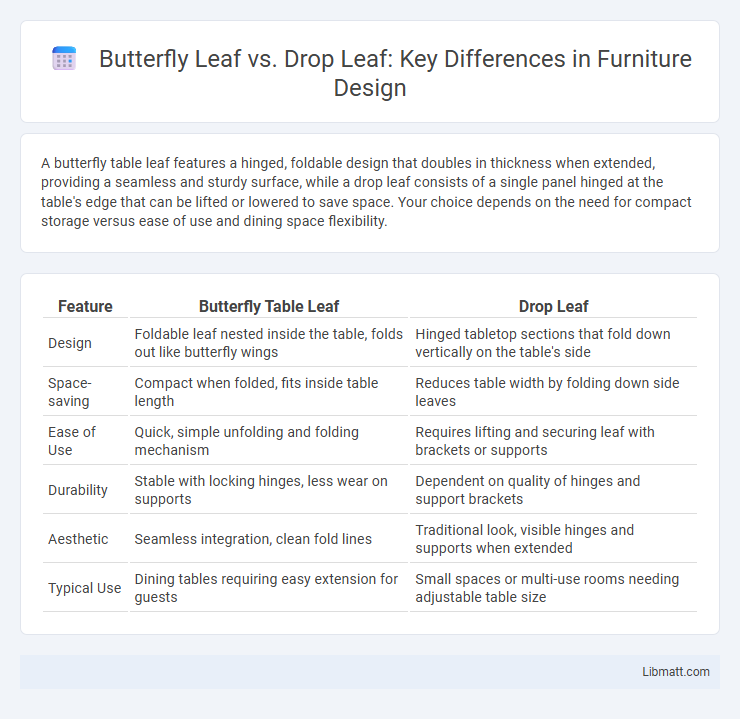A butterfly table leaf features a hinged, foldable design that doubles in thickness when extended, providing a seamless and sturdy surface, while a drop leaf consists of a single panel hinged at the table's edge that can be lifted or lowered to save space. Your choice depends on the need for compact storage versus ease of use and dining space flexibility.
Table of Comparison
| Feature | Butterfly Table Leaf | Drop Leaf |
|---|---|---|
| Design | Foldable leaf nested inside the table, folds out like butterfly wings | Hinged tabletop sections that fold down vertically on the table's side |
| Space-saving | Compact when folded, fits inside table length | Reduces table width by folding down side leaves |
| Ease of Use | Quick, simple unfolding and folding mechanism | Requires lifting and securing leaf with brackets or supports |
| Durability | Stable with locking hinges, less wear on supports | Dependent on quality of hinges and support brackets |
| Aesthetic | Seamless integration, clean fold lines | Traditional look, visible hinges and supports when extended |
| Typical Use | Dining tables requiring easy extension for guests | Small spaces or multi-use rooms needing adjustable table size |
Introduction to Table Extensions
Butterfly table leaf extensions fold in half and store neatly within the table, allowing for compact storage and quick deployment, ideal for saving space without sacrificing table length. Drop leaf tables feature hinged sections that swing down vertically on brackets, providing flexible surface area with minimal footprint when not in use. Both designs optimize versatility and space efficiency but differ in mechanism and storage method.
What Is a Butterfly Leaf Table?
A butterfly leaf table features a hinged extension that folds neatly within the table, allowing you to expand or reduce the surface area effortlessly. Unlike a drop leaf, which pivots down vertically from the side, the butterfly leaf folds inward, providing a smooth, compact profile when not in use. This design makes your table versatile for varying space needs without compromising on style or functionality.
What Is a Drop Leaf Table?
A drop leaf table features hinged sections on either side that can be lowered to save space or raised to provide additional surface area. Unlike butterfly table leaves, which fold and tuck neatly inside the table, drop leaves simply hang down when not in use, making them ideal for compact spaces. You can easily expand or contract your table to suit your needs with this versatile design.
Key Design Differences
Butterfly table leaves feature a hinged design that folds in half and tucks neatly beneath the tabletop, making them space-efficient and easy to operate. Drop leaf tables have sections that are hinged on the side and can be lifted up or lowered down vertically to adjust the table size. Understanding these key design differences helps you choose the right extension style for your space and usability needs.
Space-Saving Features Compared
Butterfly table leaves offer a unique folding mechanism that tucks neatly underneath the tabletop, maximizing space efficiency by reducing the table's footprint when not in use. Drop leaves hinge vertically, folding down to create a slimmer profile but require adjacent clearance for the leaf to hang freely. Both designs optimize space-saving in compact areas, with butterfly leaves excelling in effortless expansion and storage, while drop leaves provide flexible side extensions.
Pros and Cons of Butterfly Leaf Tables
Butterfly leaf tables feature a hinged leaf that folds and stores neatly under the table, maximizing space efficiency when not in use. Pros include easy extension without requiring additional storage space and quick setup, while cons involve potential wear on hinges and limitations in leaf size compared to drop leaf tables. Drop leaf tables offer side leaves that fold down vertically, saving floor space but sometimes limiting stability and table width flexibility.
Pros and Cons of Drop Leaf Tables
Drop leaf tables offer space-saving versatility with hinged leaves that can be folded down to reduce table size, making them ideal for small rooms or flexible dining areas. Their adjustable design allows for easy expansion when needed, but the exposed hinges and uneven support can lead to less stability compared to fixed tables. While they provide practical functionality and adaptability, drop leaf tables may require careful placement to avoid damage or imbalance.
Which Table Type Suits Your Space?
Butterfly table leaves expand your dining area by unfolding a hidden panel that doubles the surface, ideal for flexible spaces requiring occasional enlargement. Drop leaf tables save space through hinged sections that fold down vertically, perfect for compact rooms or apartments needing a regularly accessible table. Choose butterfly leaves for seamless extension and drop leaves for easy storage in tighter environments.
Maintenance and Durability Considerations
Butterfly table leaves feature hinged sections that fold under the main tabletop, requiring regular checks to ensure the hinges remain tight and free from rust, which maintains smooth operation and durability. Drop leaf tables have hinged leaves that pivot downward to reduce table size; these mechanisms demand consistent lubrication and hinge inspection to prevent sagging and wear. Both designs benefit from periodic cleaning and prompt repair of any hardware issues to ensure long-term structural integrity and ease of maintenance.
Final Thoughts: Choosing the Right Table Leaf
Choosing the right table leaf depends on your space and functionality needs; butterfly table leaves offer easy storage with their folding mechanism, making them ideal for compact areas. Drop leaf tables save space by allowing you to extend the surface quickly when needed, perfect for versatile living environments. Your decision should balance convenience, available room, and the style that complements your home's design.
Butterfly table leaf vs drop leaf Infographic

 libmatt.com
libmatt.com